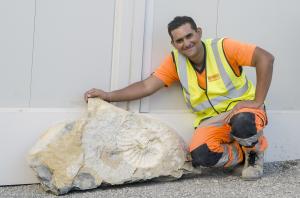Image of the week
200 million years ago at ITER
1 Oct 2018
Back in the Mesozoic, some 66 to 250 million years ago, the ITER site lay at the bottom of a shallow sea that covered most of what is now Provence.
A foreman with a sharp eye: Christopher Lebreton spotted the circular shape imprinted on a rock excavated from the platform.
The warm waters swarmed with life: marine reptiles such as ichthyosaurs and plesiosaurs, sea urchins, belemnites and the ubiquitous ammonite, resembling present-day nautiluses.
A few weeks ago, as workers excavated a gallery for the Tokamak's cooling water system, a dweller of this ancient world resurfaced.
It wasn't noticed immediately, however. "We only saw the circular shape imprinted on the rock slab once it had been delivered to the deposit area behind the construction platform," explains Christopher Lebreton, a foreman with the contractor that is performing the excavation works—SVA (Spie-Batignolles, Valérian, ADF).
The shape imprinted on the rock was that of the coiled shell of an average-size ammonite—a species which could vary in size from 20 millimetres to 2.55 metres in diameter.
According to Caroline Gamache, a geologist with Spie-Batignolles, the limestone strata where the fossil was found can be dated back 120-200 million years—a time when dinosaurs ruled the Earth and our closest parent was a tiny mouse striving to survive in the realm of the "monstrous lizards."


